Alt Trans
Bike to the future for Carmageddon II
September 13, 2012
At the end of Back to the Future, Doc coolly tells Marty “where we’re going, we don’t need roads,” before donning shades and peeling out to the sequel in a flying DeLorean.
We’re not there yet. But Los Angeles’s real-life sequel, Carmageddon II, gives L.A. a chance to prove that where we’re going, we don’t need a major freeway—at least for one weekend.
With a large segment of the 405 set to close completely during the last weekend of September, local cycling advocates are seizing the opportunity to promote their favorite driving alternative. With support from Metro, they’re organizing two “Bike Carmageddon” group rides, one on the Westside and one in the San Fernando Valley—the areas most affected by the closure.
Jim Shanman, founder of Walk ‘n Rollers and a member of the Los Angeles County Bicycle Coalition, is the main organizer of the Westside Ride.
“We want to get to people that wouldn’t otherwise be riding,” said Shanman. “This is a great way for families to get out safely with a group—there are certified trainers and no one will be left behind.”
Local officials announced the rides on Tuesday, while promoting the upcoming closure as an opportunity for people to engage with their local communities. The bike rides are just part of what’s on tap. Many businesses are offering special discounts and the art community is preparing “Artmageddon,” a region-wide art celebration that’s accessible by foot, bike and rail. The Los Angeles County Museum of Art, the Natural History Museum and the Page Museum at the La Brea Tar Pits will offer half-price admission for those who use alternative transportation to get there.
“Stay out of the car completely if you can avoid it,” said Supervisor Zev Yaroslavsky, who represents most of the affected region. “Stay local, play local, eat local, use the bike, and you’ll have a much better weekend.”
Dan Dabek, organizer of the San Fernando Valley bike ride and director of Cyclists Initiating Change through Live Exchange, or C.I.C.L.E., said bicycles and organized rides help people get a new perspective on where they live.
“The point is to show people that they can still get around their cities without getting in their cars,” said Dabek. “You connect with your city more, you can see what events are going on, visit new places and meet new people.”
The Westside Ride begins Saturday, September 29, with a kick-off party at 8:30 a.m. The 22-mile main ride will embark from Culver City Expo Station at 9 a.m. Along the path of the main ride, shorter rides will be held in Culver City, Venice, Santa Monica, and between Westwood and Santa Monica and Westwood and Culver City.
The 8-mile Metro Orange Line Valley Ride takes place Sunday, September 30 from 10 a.m. to 1 p.m. Riders will meet in the park-and-ride lot of the Balboa Orange Line Station, at 6338 Balboa Boulevard in Encino. The family-friendly, leisurely ride will traverse part of the Orange Line bike path, making stops at the Sepulveda Basin Recreation Center and the Japanese Garden before circling back to the Encino Farmers’ Market.
Both rides are free. Minors are required to wear a helmet and be accompanied by a parent or guardian and kids under 8 should use a tag-a-long, bike trailer, tandem or other safe device.
For bike activists, the underlying goal of these events is to alter daily transportation habits in the long term, even if the changes are incremental.
“They don’t have to jump in all at once,” Dabek said of new cyclists. “We are showing people how to go to the coffee shop, go to the grocery store or even bicycle to work once a week.”
With the busiest freeway in the country out of commission, Carmageddon II might be the right time to start. Shanman, of the Walk ‘n Rollers, said brand new bike infrastructure is popping up “seemingly every week,” but sometimes people need a little push to start using it.
“L.A.is such a car-centric city,” said Shanman. “We are finding that there are a lot of people that want to try out that infrastructure, but aren’t sure how to do it. This is an opportunity to get over that hump.”
Posted 9/13/12
Blazing a path by the new Orange Line
June 27, 2012
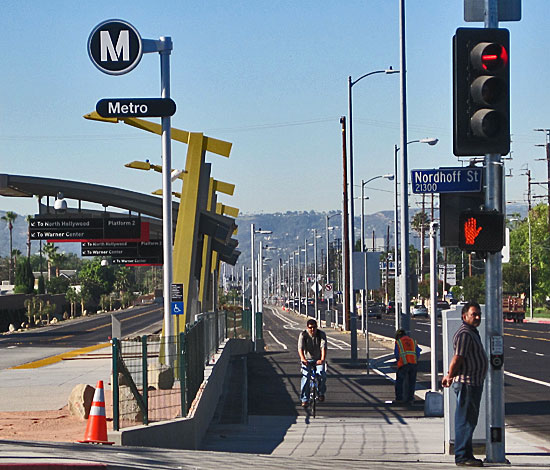
Even before it opens, the new Orange Line bike/pedestrian path is getting a workout. Photo/Dave Sotero, Metro
Bus passengers aren’t the only ones getting a slick new ride with this weekend’s opening of the Orange Line Extension.
The rapid transit busway features a dedicated bicycle/pedestrian path that’s being billed as the longest “transit-adjacent” bikeway of its kind in Los Angeles County. The path runs next to the new 4-mile northward extension of the Orange Line, which opens to the public this weekend with free bus rides on Saturday and Sunday, and connects with the original line’s 14-mile bikeway for a total of 18 miles. (By comparison, the newly-opened Expo Line bikeway is 6 miles long; it will grow to 16 miles when the line is completed to Santa Monica.)
Even before the ribbon is cut on the Orange Line Extension—which extends the popular busway northward from Warner Center to Chatsworth—cyclists and walkers have been giving the new path a workout. One project official counted 257 bicyclists and pedestrians out enjoying the new 4-mile stretch on a recent evening.
“I use it every day,” said Manny Samuel. “It’s safer for me [than the street] with all these cars.”
For Samuel, the bikeway even makes possible an old-fashioned midday break that most modern-day Angelenos can only dream of. “I’m going home for lunch,” said Samuel, who works at a nutrition research company, as he prepared to pedal from Canoga Park to Woodland Hills.
Dan Flores, out walking on a recent sunny day, said he’s already hitting the path for an average of six or seven miles a day—on foot or on bike. It’s great exercise—and a nice way to beat high gas prices. “I have a big giant truck that costs me $10 just to turn it on,” he said.
For teenagers like Anthony Winn and Gianni Darienzo, the new bike path has emerged as the preferred route to that time-honored summer destination: the mall. Compared to getting a lift in the car, “riding a bike’s better,” Darienzo said, as he and Winn returned from a trip to the Westfield Topanga Shopping Mall.
Most of the wide, asphalt-surfaced path has separate, dedicated lanes for bicyclists and pedestrians. Still, there are some “multiuse” areas in which walkers and cyclists will share space. Wider-than-usual 6-foot curb ramps also will allow cyclists and pedestrians to get on and off the path more easily, especially when it’s crowded.
Landscaping remains nonexistent along much of the path, but several hundred trees, such as incense cedars and Chinese flame trees, are set to go in soon, along with drought-tolerant plants including trailing rosemary and fortnight lilies.
The overall bus project is coming in ahead of schedule and under budget by $61.6 million, having used just $154 million of the $215.6 allocated. The acceleration was made possible, in large part, by the passage of Measure R by county voters in 2008, said project manager Hitesh Patel. Patel said the bicycle/pedestrian path is only part of a host of healthy and environmentally friendly elements incorporated into the new busway, which also has some solar-powered lighting panels, bioswales to naturally filter runoff water and even recycled construction debris from the 405 Project, which has been crushed and used as an underground base.
Those who want to ride the new busway extension can do so for free on Saturday, June 30, and Sunday, July 1. (The free rides are being offered only on the extension portion of the Orange Line running from Canoga Park to Chatsworth.) There also will be family-friendly festivities from 10 a.m. to 4 p.m. on Saturday at the Canoga Park and Chatsworth stations.
Those include a group ride with Valley Bikery, which sets out from the Canoga station at 1 p.m. and finishes at the Chatsworth station.
Nathan Baird, bicycle coordinator for the Los Angeles Department of Transportation, said he expects to see cyclists using the bike path—and the Orange Line itself—in a variety of ways.
“Having the bike path right next to the transit gives you a whole slew of options,” he said.
And the sheer 18-mile length of the path is a major plus, he said.
“The miles are important,” Baird said. “It connects across the entire Valley.”
Those connections eventually will go even further.
In the not too distant future, he said, cyclists will be able to start on the Browns Creek bike path in Chatsworth, connect with the Orange Line bikeway, travel along dedicated bike lanes through stretches of Los Angeles and Burbank and end up on the L.A. River bike path, which in turn will open up new connections stretching all the way to Long Beach.
As Patel, the project manager, puts it: “It’s going to be a wonderful asset for the San Fernando Valley…and for bicyclists, runners and nature lovers across the county.”
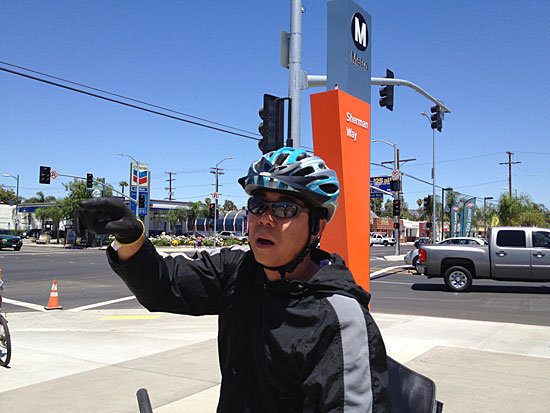
Manny Samuel, who lives in Woodland Hills and works in Canoga Park, uses the bikeway to ride home for lunch.
Posted 6/27/12
Rollin’ on the river
June 5, 2012
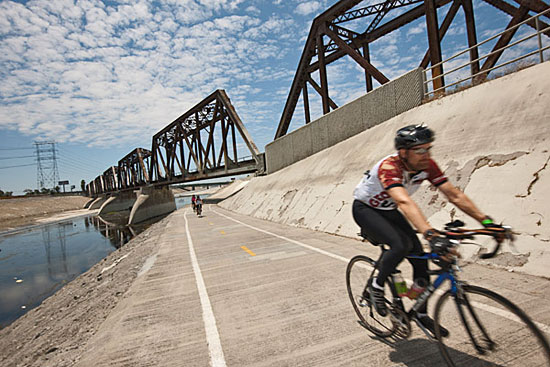
The L.A. River Ride bridges the past, present and future of the cycling revolution. Photo/Minami Pictures
Years before Los Angeles streets went car-free for the freewheeling festivities known as CicLAvia, bike advocates were already forging a path with the L.A. River Ride.
Now in its 12th year, the L.A. River Ride, which takes place on Sunday, is not just the granddaddy of local cycling activism. It’s also riding a growing wave of bike popularity, with new and veteran riders pedaling together in celebration of a still-evolving regional cycling culture.
“Committed cyclists ride by ourselves every day,” said Joe Linton, one of the event’s founders, along with Ron Milam and Chuck Arnold. “Group rides make us feel more connected with each other—and are a great way to welcome newer, less experienced riders into the fold.”
Since its beginning, the ride has generated support for two causes—bike advocacy and the health of the L.A. River. The event is now the yearly fundraiser for the Los Angeles County Bicycle Coalition, a nonprofit bike advocacy organization.
“We were one foot in river activism and one foot in bike activism,” Linton said.
In the late 1990s, before the first River Ride, the three activists organized a series of prototype events with Friends of the L.A. River and Occidental College. According to Linton the events were successful, and gave bikers a chance to see a “natural” side of the L.A. River.
“One of the big things about the L.A. River is that people don’t know where it is,” said Linton. “I think a lot of people imagine it is all concrete like in the movies Terminator and Grease.”
Although the ride draws attention to the river, its main thrust has always been about expanding bikeways. To help get federal funding for the inaugural River Ride in 2001, Linton pitched the goal of a continuous 50-mile bike path along the river, from the San Fernando Valley to Long Beach.
In 1998, around the same time the ride was beginning to take shape, Linton and Milam co-founded the Los Angeles County Bicycle Coalition. According to J.J. Hoffman, a coalition member who has organized the River Ride since 2005, the event and the organization have grown in symbiosis. The first ride drew 780 cyclists. When the bike coalition expanded in 2007, attendance doubled. Organizers expect this year’s event to draw about 2,500 cyclists.
The goal of a 50-mile continuous path along the L.A. River remains elusive, but there has been progress. When the event began there were 18 miles of bike path, built in the 1970s. Now there are nearly 30 miles of path, with another 1.5 miles to be added later this year as the West Valley River Bike Path moves towards completion. When the Metro Orange Line Extension to Chatsworth opens on June 30, 4 miles of bike path perpendicular to the river will open with it, eventually connecting to a part of the river path planned for the future. Hoffman says the cycling community is eager to keep adding to the total.
“Having 50 miles of uninterrupted bikeway in Los Angeles would be like having our own bike freeway,” said Hoffman.
This year’s ride takes place on Sunday, June 10. Registration starts at 6:30 a.m. The route will take riders along the river where path currently exists, and will detour around parts of the river where there’s no path yet. Security will patrol the route with radios to ensure riders stay safe. Helmets are required, and technical and medical support will be available along the ride.
There are 7 different ride options to choose from, from a 100-mile Century Ride to a 15-mile Family Ride and an even shorter Kids’ Ride. Registration ranges from $50 to $65 except for the Kids’ Ride, which is free. Most rides begin and end at the Autry Center in Griffith Park, where festivities will be held, including an International Food Fair, an “Eco Expo,” live music and a raffle. Rest stops in Elysian Valley, Hollenbeck Park, Maywood Recreational Park, Dill’s Park and Long Beach Shoreline Park will also feature food, music and entertainment. Visit the event page for more details.
Cyclists are encouraged to raise money by having people sponsor their rides. For the first time, this year the top fundraiser will win a 10-day guided bike tour of the Tuscany coast in Italy, and runners-up will win bike parts and apparel. Those who want to support the cause but can’t join in can sponsor the ride or make a donation.
This year’s grand marshal, Bobby Gadda, serves as the President of the Board of Directors of CicLAvia. Gadda said both events offer something unique:
“Both CicLAvia and the River Ride are all about families enjoying biking in the streets, using the public space in a different way.”
This Sunday, Gadda will lead rides out from Griffith Park, high atop his famous tall bike. There will be a lot of folks behind him, and even more behind a growing, healthy movement from gas power to pedal power.
Posted 6/5/12
Bike Week’s cycle of celebration
May 10, 2012
Bicycles keep gaining traction in Los Angeles County. With the most recent edition of CicLAvia behind us, it’s time to celebrate pedal power during the 18th Annual Bike Week, May 14-18.
Metro, the Los Angeles County Bicycle Coalition and other community organizations are partnering for five days of bike festivities, beginning Monday with a 10 a.m. kick-off celebration at the University of Southern California’s Galen Center. New initiatives to promote bicycling will be announced at the event.
After that, on Tuesday, clergy of various religions will perform the 9th Annual Blessing of the Bikes at Good Samaritan Hospital from 8 a.m. to 9:30 a.m. Cyclists who attend can also receive the earthly blessings of a free bike check-up and breakfast.
On Wednesday, cyclists can “test pedal” the new Expo Line bike lanes on a mid-city ride, which meets at the Expo Park/USC station at 8 a.m. and departs at 8:30 a.m.
Thursday, May 17, is Bike to Work Day. Metro and other local transit agencies will give free rides to anyone with a bike or a helmet, and local cycling organizations and businesses will host dozens of pit stops with free refreshments and giveaways. After the workday is over, participants can join fellow riders at one of several after parties.
The week concludes on Friday with Bike to School Day, which takes aim at reducing traffic congestion in school zones.
Bike Week will give the public 5 days’ worth of reasons to avoid the hassles of driving while getting some healthy exercise with L.A.’s growing cycling community. To keep safe on the roads, check out these quick tips from Metro.
Posted 5/9/12
Freewheeling at CicLAvia
April 12, 2012
If lack of a bicycle is the only thing keeping you from CicLAvia, there’s no excuse now—you can grab one for free from Bike Nation.
A hundred bikes will be available for 90 minute reservations at the upcoming edition of CicLAvia, which takes place from 10 a.m. to 3 p.m. on Sunday, April 15th. Each person can reserve a maximum of two bikes. Helmets will not be provided, so riders are strongly encouraged to bring their own. The bikes will be located at the MacArthur Park and El Pueblo “hubs” for start times of 10 a.m., 11:30 a.m. and 1 p.m. For a full event map, click here.
Ethan Fiamingo, chief technical officer for Bike Nation, said most reservations so far have been made by people who live downtown or by public officials who don’t want to haul their own bikes or perhaps don’t have one. As of Wednesday, only 130 of about 300 available time slots were filled, but the bulk of demand is expected to come from “walk up” traffic.
Bike Nation has provided cycles for events in the past, but none of the magnitude of CicLAvia. The company approached CicLAvia organizers during preparations for the October, 2011, event, which drew tens of thousands of participants.
“Any time they shut down the streets of L.A. for something, you know it’s going to be huge,” Fiamingo said.
Bike Nation was one of several companies that participated in Metro’s “bike sharing demonstration” earlier this year (see video above). Acting on a July, 2011, motion by Metro board member Zev Yaroslavsky and others, Metro began planning for a permanent bike share program to provide short-term, automated bike rentals. Bike sharing is designed to give commuters a way to get to and from mass transit stops near their homes and workplaces, as well as provide a healthy alternative to short car trips for errands. Similar systems are already in place in Denver, Paris and Washington D.C.
“We have been working with the city and organizations like Metro for the past two years to bring bike sharing to L.A.,” said Derek Fretheim, Bike Nation’s chief operating officer. “CicLAvia seemed to be a worthwhile event to increase bicycling awareness and bicycle behavior.”
Other than Bike Nation, there are a few other options to get wheels in time for CicLAvia. Downtown L.A. Bicycles, DTLA Bikes and Flying Pigeon L.A. are offering paid rentals.
Posted 4/12/12
County gets a new bike plan at last
February 28, 2012
After 37 years, multiple revisions and a flurry of last-minute additions, Los Angeles County finally has a new bicycle master plan intended to create a more cycling-friendly environment in unincorporated areas over the next two decades.
The Bicycle Master Plan, adopted by the Board of Supervisors on a 4-0 vote, with Supervisor Michael D. Antonovich abstaining, represents the first overhaul of county bike policies in place since 1975.
The new bike master plan “will give us a real road map, no pun intended, to take our bicycle planning and implementation to a new level,” Board Chairman Zev Yaroslavsky said.
When fully realized by 2032, the plan will vastly expand the existing 144-mile network, adding 832 miles of new bikeways in unincorporated areas at an estimated cost of $331 million. Significantly, it also formally signals that the county wants to become an innovator in incorporating bikeway facilities into a metropolis known worldwide for its automobile-centric ways.
Work on the plan started in 2008, said Mary Reyes of the Department of Public Works, which developed the biking blueprint along with other county departments including Regional Planning and Public Health. She said it was created against the backdrop of a national movement increasingly championing bicycling as an important and desirable transportation alternative in a society battling problems ranging from high gas prices to chronic diseases driven by physical inactivity.
Los Angeles cycling advocates, initially discouraged by what they saw as a business-as-usual approach in the plan’s early stages, praised the county on Tuesday for making a sharp U-turn toward innovation at the end of the process.
County staffers have “risen to the challenge to make this a really visionary plan,” said Alexis Lantz, planning and policy director for the Los Angeles County Bicycle Coalition.
Another activist, USC cycling team coach Eric Bruins, said the plan could be “a model for the rest of the country.” The Board of Supervisors, acting on a motion by Yaroslavsky, directed county bicycle planners in November to come up with a revised master plan that included forward-looking features such as painted bike lanes and “cycle tracks,” in which a barrier separates bike lanes from car traffic.
On Tuesday, there was more fine-tuning to do. A motion by Yaroslavsky and Supervisor Don Knabe changed the wording of the plan to mandate that one kind of innovative treatment—the “bicycle boulevard,” usually designated on a less-busy local or residential street—include traffic-slowing measures as a matter of course.
The plan calls for creating 22.8 miles of such bike boulevards. Traffic-calming measures, such as speed bumps, have been promoted by cycling advocates, who say they are essential to making riders of all ages and abilities, especially families and children, feel safe and comfortable taking to the boulevards. Specific designs for the boulevards will be developed as the plan rolls out, with individual neighborhoods providing input on how the routes will work in their areas.
In addition to bike boulevards, the new plan features almost 274 miles of bike lanes and nearly 72 miles of dedicated bike paths.
Most of the network, however, is devoted to some 463 miles’ worth of “Class III” bike routes—the lowest class of bikeway, with signage but no dedicated space for cyclists.
Some of those Class III routes could be upgraded to full-fledged bike lanes under the Yaroslavsky-Knabe motion, which allows engineers to make the change with a minimum of red tape in suitable locations.
Another motion, by Supervisor Mark Ridley-Thomas, directed county officials to come up with ways to incorporate bike parking at county facilities wherever possible. It also asked for a report on the 10 unincorporated areas with the highest obesity rates, and for implementation and funding plans to get bikeways going in those and other areas. And it directed that a recommended bike route along the Sepulveda Channel in Mar Vista be deleted from the plan. Some in the neighborhood have expressed concerns about the bikeway’s potential for bringing crime into their area.
Antonovich, who abstained from the vote, asked a series of questions about how the bikeways would be funded and said he was concerned about using county road construction funds or Measure R revenue to create the network.
Pat DeChellis, deputy director of Public Works, said road construction funds by law may only be used for small “incidental expenses” such as signs or painting new bike lanes when a road project is being built or repaired. “The vast majority of the expenses, the 300-plus millions of dollars, are going to come from federal, state and regional grant sources,” DeChellis said, with the county providing varying levels of matching funds.
In the bigger scheme of things, the funding required to build the bike network is reasonable, said Lantz, of the bicycle coalition. “This plan is $331 million to complete the entire thing. That’s only a third of the 405 widening project,” she said. “So while it sounds like a lot of money, it’s a lot less than what we’re spending right now to expand our highway system.”
Posted 2/28/12
Sisterhood of the traveling bikes
February 7, 2012

The movement to increase the number of women cyclists on L.A. streets includes Andrea Denike Martinez.
Andrea Denike Martinez still remembers the day she got back in the saddle.
It was Earth Day—April 22, 2010. For the first time since a bad bicycle accident fractured her skull and landed her in intensive care several years earlier, Martinez was ready to once again brave L.A.’s streets on two wheels.
Heading out from her Echo Park home, she was pumped up with environmental commitment—and “so nervous,” she recalled.
But moral support was also on the road that day. “I met another girl on a bike going that very same route.” She was a total stranger, but Katherine Gladwin was going in the same direction so they rode together to their jobs near Wilshire and Western.
They not only became fast friends, but started a small women’s cycling crew they dubbed the Bodacious Bike Babes. Since that first commute, they’ve organized and publicized group rides, volunteered at events like CicLAvia, and generally tried to encourage other women to take the plunge into an L.A. cycling world that remains overwhelmingly dominated by men.
Even though they may have felt alone out there at times, Martinez and Gladwin have plenty of company these days. On Wednesday, February 8, a coalition of women cycling advocates is set to gather in Long Beach to announce an ambitious goal: doubling the number of female bicyclists on Southern California streets within five years.
The initiative is led by a relatively new organization, Women on Bikes SoCal, which seeks to promote the “joy, beauty and benefits of bicycling for women.” Its campaign includes establishing the nation’s first women-only scholarship program for League Certified Bike Safety Instructors. (Information on supporting the initiative is here.)
One of the most visible faces of female cycling in Southern California, Long Beach Vice Mayor Suja Lowenthal, is among those backing the movement.
On a recent bicycle tour of her city, which is noted for its large and growing network of bike-friendly amenities, Lowenthal made it clear that dressing like Lance Armstrong—and riding like a Tour de France champion—are not required to join the cycling revolution.
“I want to wear my heels. I want to do all sorts of kinds of things that are about regular lifestyle,” Lowenthal said. “You don’t have to be the 50-mile-a-week spandex athlete. You can move about with your children and make it a very family-oriented, healthy, active lifestyle.”
In fact, Lowenthal thinks that the health and well-being of kids can be a powerful motivator in getting women to take up cycling. Childhood obesity is a “crisis of epic proportions,” she said, and there’s nothing like getting mothers on bikes to get everyone else onboard, too. “It is that green light: ‘Well, Mom’s OK with it,’ “ she said.
Still, if current statistics are any indication, there may be an uphill climb ahead.
The Los Angeles County Bicycle Coalition reports that only 16% of cyclists spotted during last year’s bicycle count were women—about the same percentage as in the previous count in 2009. A new report by the national advocacy group Alliance for Biking and Walking found that only 20% of those bicycling to work in Los Angeles are women—compared to 33% in Sacramento, 38% in Portland and a remarkable 49% in Memphis.
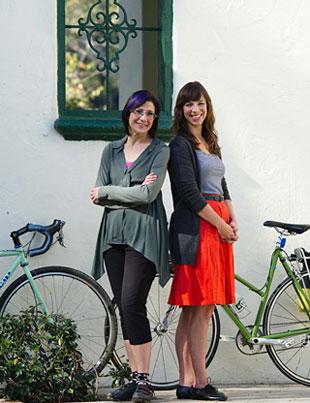
Jennifer Klausner, left, and Alexis Lantz of L.A. County Bicycle Coalition. Photo by Allan Crawford/Women on Bikes SoCal
Ask L.A. women cyclists, non-cyclists and would-be cyclists about the imbalance, and most are quick to sum up the problem in two words: too dangerous.
“A lot of it is people really are deathly afraid of cars, and the way people drive,” said Martinez, 33, co-founder of the Bodacious Bike Babes.
“It’s just too stressful being on the road,” added Kristen Schwarz, 28, who lives in East Hollywood and gave up her bicycle a couple of years ago after one too many encounters with speeding motorists. “It’s tough out there!”
Everyone, it seems, has a harrowing story or two.
“My first experiences in L.A. were pretty terrifying. I went down Wilshire. It was definitely a treacherous route,” said Gladwin, Martinez’s friend and co-founder. “My bicycling career in Los Angeles started in a pretty daunting fashion.”
She’s been struck twice by cars, the first time by a morning rush hour driver who mowed her down on Wilshire. “She stopped and she actually was complaining about heart palpitations because of the trauma she had experienced,” said Gladwin, 29, who was thrown to her knees in the collision. “I was intimidated but I wasn’t going to let that deter me.”
Magdalena Paluch, who interviewed women cyclists as part of a project to create a bicycling app while she earned her master’s degree in industrial design at Pasadena’s Art Center College of Design, said greater female involvement could lead to big things.
“I feel strongly that if anything will change, most of the time it changes because of the women. We are change agents,” she said. “Women are considered an ‘indicator species’ for biking and public transit because women are risk-averse. If you make it safe for women to bike, it’ll be safer for everybody.”
Cycling advocates agree. They say that creating more, and safer, facilities like “protected bike lanes”—in which riders are buffered from car traffic—and “bicycle boulevards” on slower-moving residential streets is the key to overcoming the perception and reality of dangerous L.A. streets.
Joe Linton, a CicLAvia consultant and longtime L.A. bicycle activist, noted that the gender disparity disappears in countries like the Netherlands, which has a highly developed network of bikeways and a culture in which cycling is considered a safe and commonplace way to get around.
“In very bicycle-safe cultures, women are actually the majority. In daredevil places, or places that are perceived as daredevil, like L.A., women are reluctant, and reluctant to go with kids,” Linton said. In Los Angeles, where men have long dominated the bike scene, it’s easy for experienced, hardcore cyclists to forget how women—and other less confident beginning riders—may view the challenges of the road, he said.
Advocates are increasingly pointing to women riders’ safety concerns as a way of advancing a broader agenda of making streets better for all cyclists and pedestrians, of all ages. “This is a growing issue,” said Alexis Lantz, planning and policy director for the Los Angeles County Bicycle Coalition.
In fact, the women’s safety argument has been made as part of a push for improvements in Los Angeles County’s Bicycle Master Plan, set to come before the Board of Supervisors in the weeks ahead.
Lantz said it also could be a factor as advocates press for more bicycle resources in the Southern California Association of Governments’ Regional Transportation Plan. And, on the federal level, she said, “Safe Routes to School” funding—which provides resources for many bicycle and pedestrian programs and is now threatened as part of the budget showdown in Washington—is another area in which women’s street safety concerns are a big part of the conversation.
Beyond the public policy arena, signs are everywhere that women are finally starting to make their move into the bike lane—at least a little bit.
Photos of bike-riding celebs like Zoe Deschanel, Hilary Duff and Vanessa Hudgens are all over the Internet, as are fashion-forward blogs such as Los Angeles Cycle Chic. Monday nights are reserved for women at the Bicycle Kitchen. Although nobody’s done a formal count, popular street-closing CicLAvia events seem to be bringing out large numbers of women. And young female activists are creating crews like Iron Unicorns, dedicated to creating “equality for women cyclists, both on the streets and in society.”
All those are valuable in building the women’s cycling movement, Lantz said.
“I think there is something that everyone can bring,” she said. “Cycle chic is a really great way of promoting cycling for some women. I really think that the more attention brought to cycling, the better.”
Posted 2/7/12
Give bike-sharing a test drive
January 12, 2012
They share bikes in Paris and Portland, so why not here?
Metro’s inviting the public to a bike share demonstration on Wednesday, January 18.
The agency currently is looking into whether to adopt a bike share program offering short-term bicycle rentals through an automated system, such as a computerized kiosk. (See the motion by Metro board members Zev Yaroslavsky, Pam O’Connor and Antonio Villaraigosa here.)
Three vendors will roll out their bikes for the demonstration at Metro headquarters downtown. The event runs from 10 a.m. till 2 p.m. For more information, click here.
Posted 1/12/11
Getting creative with county bike plan
November 30, 2011
The wheels are in motion.
The county’s bicycle master plan—its first in 36 years—is about to get more innovative as it heads toward the finish line, Department of Public Works director Gail Farber said this week.
Responding to a unanimous push from the Board of Supervisors, the county’s bike planners will get to work on integrating more forward-looking design elements into the cycling master plan within the next 45 days, Farber said.
The board acted on a motion by Supervisor Zev Yaroslavsky which said the new bike plan should “not just move us out of the 1970’s, but move Los Angeles County forward as a leader in 21st Century bicyclist safety and comfort.”
To get there, the motion said the plan should incorporate “leading edge” designs such as those found in the Model Design Manual for Living Streets recently completed by the county Department of Public Health. Among the proposed innovations are varied lane and sidewalk widths, bolder paint treatments of bike lanes and “cycle tracks,” which separate bike lanes from traffic.
“The motion sends a clear message that the plan needs to do more to make the county a better and safer place to bike,” Farber said. “The board wants us to embrace these design concepts and we certainly plan to do so.”
Cycling advocates have been pressing for a bolder and more ambitious master plan, which will serve as a blueprint for bike facilities in unincorporated Los Angeles County for the next 20 years. The plan as currently drafted would add 816 miles of new bikeways over the next two decades, at a cost of $327.7 million.
The motion approved Tuesday represents a proactive approach to the bike plan, which must be approved by the county’s Regional Planning Commission before the Board of Supervisors formally takes it up early next year.
Testifying before the supervisors’ vote Tuesday was Alexis Lantz of the Los Angeles County Bicycle Coalition. She said the motion provided “guidance to staff” to create a plan that “truly improves the safety of our roadways, especially for people who need or choose to bicycle to meet their daily needs.”
A “visionary” bike plan could play a role in creating a healthier and more livable Los Angeles County over the next two decades, she said.
Farber said continued collaboration with the cycling community will be important as the plan moves forward. And she said she sees retooling the current draft as “more of an opportunity” than an obstacle.
“We’re excited,” Farber said. “We embrace the input.”
Posted 11/30/11




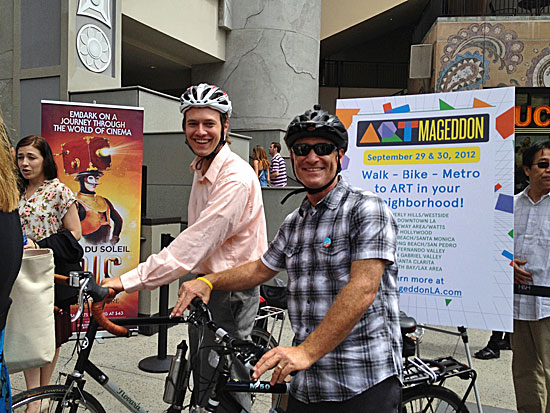
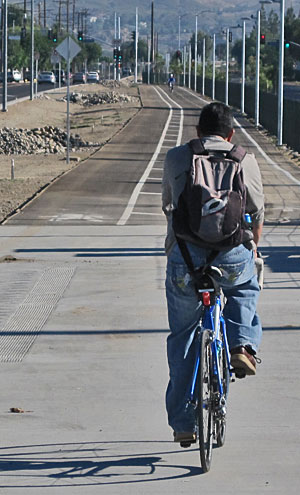
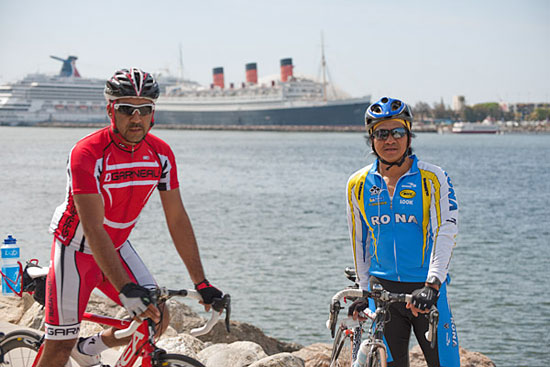
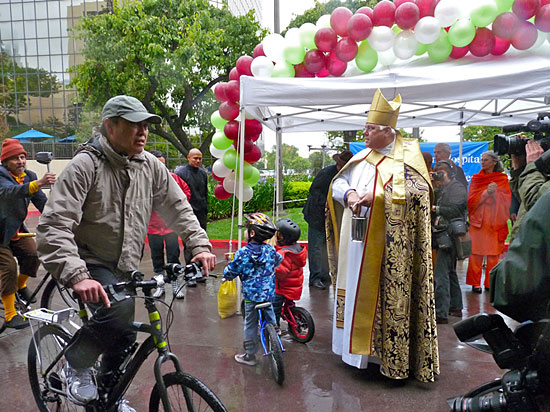
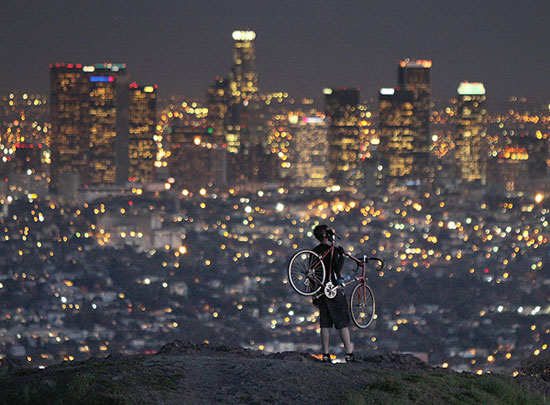
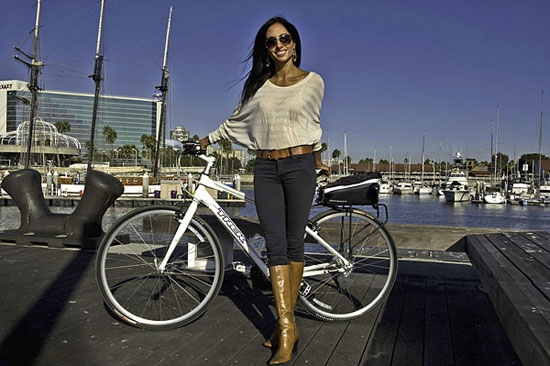
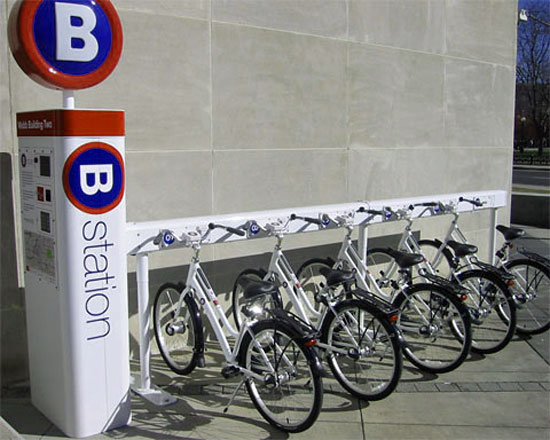
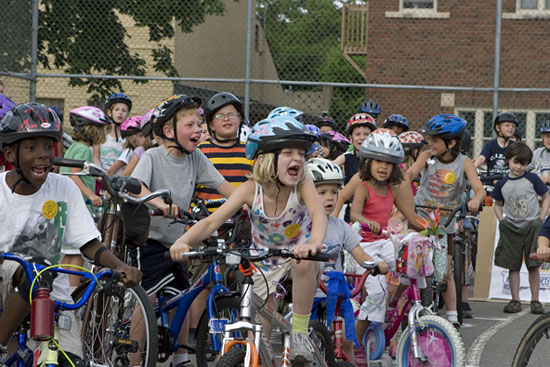







 405 bridge work causes a stink
405 bridge work causes a stink

